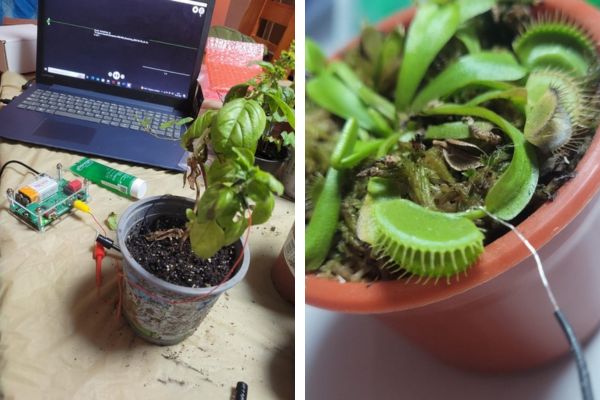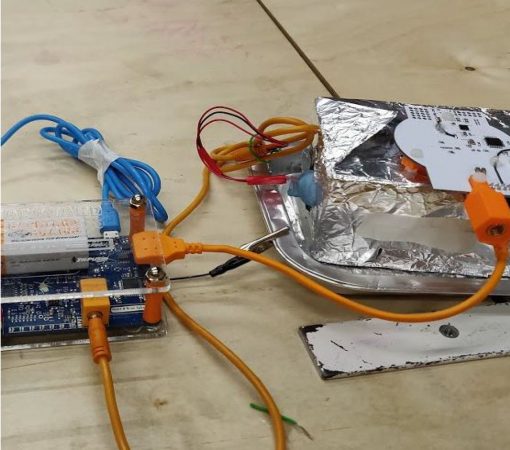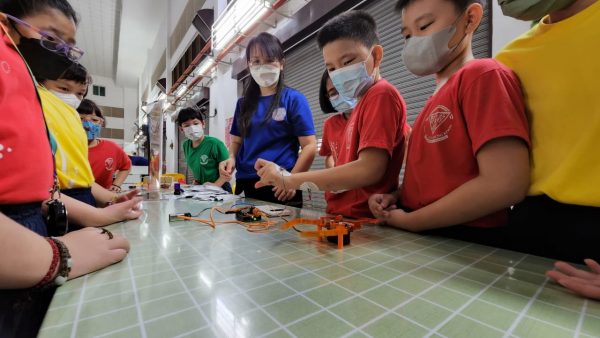-
 EducationThere's something special about our new Chilean interns: They are high schoolers who teach neuroscience to elementary school kids! This is their blog post.
EducationThere's something special about our new Chilean interns: They are high schoolers who teach neuroscience to elementary school kids! This is their blog post. -
 EducationIt spins, wiggles or beeps when it detects certain colors and shapes. It chases or runs away from objects. It learns and solves problems, and does it all much like your own brain: thanks to neural networks comprising of neurons, synapses and an occasional shot of dopamine to reinforce this or that behavior. High school […]
EducationIt spins, wiggles or beeps when it detects certain colors and shapes. It chases or runs away from objects. It learns and solves problems, and does it all much like your own brain: thanks to neural networks comprising of neurons, synapses and an occasional shot of dopamine to reinforce this or that behavior. High school […] -
 EducationIn an article we previously published in June 2022 about our scientific paper that dealt with play behavior in fish, I concluded at the end of the article: “I think it is possible for novices and high school students to publish papers (and it is the dream and goal of our team)… That is why we […]
EducationIn an article we previously published in June 2022 about our scientific paper that dealt with play behavior in fish, I concluded at the end of the article: “I think it is possible for novices and high school students to publish papers (and it is the dream and goal of our team)… That is why we […] -
 Education— Written by Carla Contreras Mena — Hello! Carla Contreras Mena from Santiago, Chile, here again. Welcome to the conclusion of my work during my internship with Backyard Brains. Experiment Update In the last few months, I’ve had to study more about plants. Why? Because, In my daily life in the laboratory, I’m not very familiar with the […]
Education— Written by Carla Contreras Mena — Hello! Carla Contreras Mena from Santiago, Chile, here again. Welcome to the conclusion of my work during my internship with Backyard Brains. Experiment Update In the last few months, I’ve had to study more about plants. Why? Because, In my daily life in the laboratory, I’m not very familiar with the […] -
 Education— Written by Carla Contreras Mena — Hello, I’m Carla Contreras Mena, a student of Biochemistry at the University of Santiago of Chile (which we locally call Usach). I currently work in a Neuroscience Laboratory with professor Dr. Patricio Rojas, where we are investigating the neurophysiological difference of electrical activity in the mouse hippocampus between a […]
Education— Written by Carla Contreras Mena — Hello, I’m Carla Contreras Mena, a student of Biochemistry at the University of Santiago of Chile (which we locally call Usach). I currently work in a Neuroscience Laboratory with professor Dr. Patricio Rojas, where we are investigating the neurophysiological difference of electrical activity in the mouse hippocampus between a […] -
 Education[Updated February 2024] There’s one thing that beats inspiring kids to take up neuroscience: Watching them not only catch the spark but pass it along! High schooler Supriya Nair is our case in point. Through scientific outreach using our SpikerBox, she has already ignited the interest of hundreds of her peers who got to see and […]
Education[Updated February 2024] There’s one thing that beats inspiring kids to take up neuroscience: Watching them not only catch the spark but pass it along! High schooler Supriya Nair is our case in point. Through scientific outreach using our SpikerBox, she has already ignited the interest of hundreds of her peers who got to see and […] -
 Education— Written by Tim Marzullo — Jeopardy is an American institution, and we have fond memories of watching their episodes with our families during our youth. We still watch reruns to relax, and recently something caught our eye. While watching episode 8364, which originally played on March 21, 2021 (Season 37) with guest host Dr. Mehmet […]
Education— Written by Tim Marzullo — Jeopardy is an American institution, and we have fond memories of watching their episodes with our families during our youth. We still watch reruns to relax, and recently something caught our eye. While watching episode 8364, which originally played on March 21, 2021 (Season 37) with guest host Dr. Mehmet […] -
 Education— Written by Tim Marzullo — Over the past 80 years, we have exploited the invention of computers to make calculations much faster than our human brains can. From the ENIAC machines of post-WWII predicting ballistic trajectories to the contemporary Google Colab notebooks we now use that process our team’s electrophysiology data in the cloud, we […]
Education— Written by Tim Marzullo — Over the past 80 years, we have exploited the invention of computers to make calculations much faster than our human brains can. From the ENIAC machines of post-WWII predicting ballistic trajectories to the contemporary Google Colab notebooks we now use that process our team’s electrophysiology data in the cloud, we […] -
 EducationEditor’s note: This is Part II. You can read Part I here. Danae Hello, I am Danae Madariaga, a senior at Alberto Blest Gana high school. I have participated in a data collection project with Etienne, Tim, and Derek for three months. Throughout this time, I have learned many things such as the use of Google Colab […]
EducationEditor’s note: This is Part II. You can read Part I here. Danae Hello, I am Danae Madariaga, a senior at Alberto Blest Gana high school. I have participated in a data collection project with Etienne, Tim, and Derek for three months. Throughout this time, I have learned many things such as the use of Google Colab […] -
 EducationWe could be living through the 6th mass extinction, but there’s encouraging news: the preservation of insect biodiversity begins in our backyards. And it doesn’t need all of us to be Jane Goodalls. All we need is a cheap ERG bioamplifier, a smartphone, some patience, and as little (or as much!) scientific training as we […]
EducationWe could be living through the 6th mass extinction, but there’s encouraging news: the preservation of insect biodiversity begins in our backyards. And it doesn’t need all of us to be Jane Goodalls. All we need is a cheap ERG bioamplifier, a smartphone, some patience, and as little (or as much!) scientific training as we […] -
 EducationDerek Arro I am Derek Arro, a senior student at High School Alberto Blest Gana in Santiago, Chile. Currently, I have been working at Backyard Brains for 2 weeks, and I’m in charge of helping to write the manuscript for the experiments my team did with plant electrophysiology last semester. Backyard Brains is an incredible team that designs […]
EducationDerek Arro I am Derek Arro, a senior student at High School Alberto Blest Gana in Santiago, Chile. Currently, I have been working at Backyard Brains for 2 weeks, and I’m in charge of helping to write the manuscript for the experiments my team did with plant electrophysiology last semester. Backyard Brains is an incredible team that designs […] -
 EducationWe’re ending the eventful year of 2022 grand style – by sending our gear on yet another trip across the world to further our #NeuroRevolution! This time, it was George Town in Penang, Malaysia, where school kiddos got to try their hands at our Claw. The neuroscience booth was part of an exhibition funded by American […]
EducationWe’re ending the eventful year of 2022 grand style – by sending our gear on yet another trip across the world to further our #NeuroRevolution! This time, it was George Town in Penang, Malaysia, where school kiddos got to try their hands at our Claw. The neuroscience booth was part of an exhibition funded by American […]